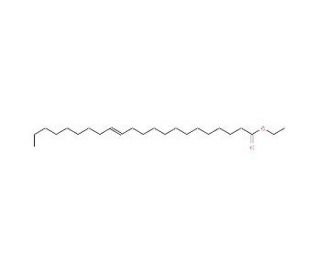

Ethyl erucate (CAS 37910-77-3)
ENLACES RÁPIDOS
El erucato de etilo, con el número CAS 37910-77-3, es un éster formado a partir de la condensación de etanol y ácido erúcico, un ácido graso monoinsaturado que se encuentra predominantemente en aceites de plantas de la familia Brassica, como la colza. Este producto químico se caracteriza por su larga cadena de hidrocarburos terminada en un grupo éster etílico, que contribuye a sus propiedades similares a las de los lípidos, como la hidrofobicidad y la estabilidad. El erucato de etilo se utiliza principalmente en el campo de la investigación por sus propiedades fisicoquímicas, que son similares a las de los lípidos naturales, lo que lo convierte en un componente valioso en el estudio de las membranas lipídicas y los sistemas de administración basados en lípidos. Su incorporación a bicapas lipídicas puede utilizarse para investigar los efectos de la longitud y la saturación de la cadena en la fluidez y la permeabilidad de la membrana. En el ámbito de la investigación, el erucato de etilo sirve como compuesto modelo para comprender el comportamiento de los ésteres de ácidos grasos en diversos procesos industriales y bioquímicos. Su utilidad se extiende a la ciencia de materiales y la bioingeniería, donde se emplea en la formulación de plásticos biodegradables y biocombustibles debido a su origen renovable y a sus atributos químicos favorables. Además, el estudio de las interacciones del erucato de etilo con otras sustancias bioquímicas ayuda a dilucidar los mecanismos de las interacciones lípido-lípido y lípido-proteína en sistemas biológicos más complejos.
Ethyl erucate (CAS 37910-77-3) Referencias
- El aislamiento del ácido behénico a partir de la cera mona refinada. | Reilly, J., et al. 1943. Biochem J. 37: 195-8. PMID: 16747616
- ¿Qué poliésteres pueden imitar al polietileno? | Stempfle, F., et al. 2013. Macromol Rapid Commun. 34: 47-50. PMID: 23161497
- Síntesis, propiedades y aplicaciones de polímeros biodegradables derivados de dioles y ácidos dicarboxílicos: de los poliésteres a las poli(éster amida)s. | Díaz, A., et al. 2014. Int J Mol Sci. 15: 7064-123. PMID: 24776758
- Poliamidas de base biológica: Avances recientes en investigación básica y aplicada. | Winnacker, M. and Rieger, B. 2016. Macromol Rapid Commun. 37: 1391-413. PMID: 27457825
- Evaluación de los efectos de la técnica de procesado en los componentes químicos del semen de Raphani mediante HPLC y UPLC-Q-TOF-MS. | Gao, S., et al. 2022. Int J Anal Chem. 2022: 8279839. PMID: 35027928
- Nanocristales Poliméricos Autoestabilizados de Microestructura Precisa. | Ortmann, P., et al. 2013. ACS Macro Lett. 2: 125-127. PMID: 35581773
- Combinación de vías ortogonales de biosíntesis de ácidos grasos vegetales y no vegetales para la producción eficiente de aceite microbiano enriquecido en ácido nervónico en Yarrowia lipolytica. | Wang, K., et al. 2023. Bioresour Technol. 378: 129012. PMID: 37019413
- Poliésteres reciclables y no persistentes similares al polietileno de ciclo cerrado. | Eck, M. and Mecking, S. 2024. Acc Chem Res. 57: 971-980. PMID: 38446139
- Curvas del punto de solidificación de mezclas ácidas binarias | , et al. 1945. Oil amp: Soap. 22: 107–109.
- Preparación y propiedades como combustible de ésteres etílicos de aceite de semillas de berro de campo (Thlaspi arvense) y mezclas con combustible diesel ultrabajo en azufre | Moser, Bryan R., Roque L. Evangelista, and Terry A. Isbell. 2016. Energy & Fuels. 30: 473–479.
Información sobre pedidos
| Nombre del producto | Número de catálogo | UNIDAD | Precio | CANTIDAD | Favoritos | |
Ethyl erucate, 25 g | sc-294550 | 25 g | $49.00 |
